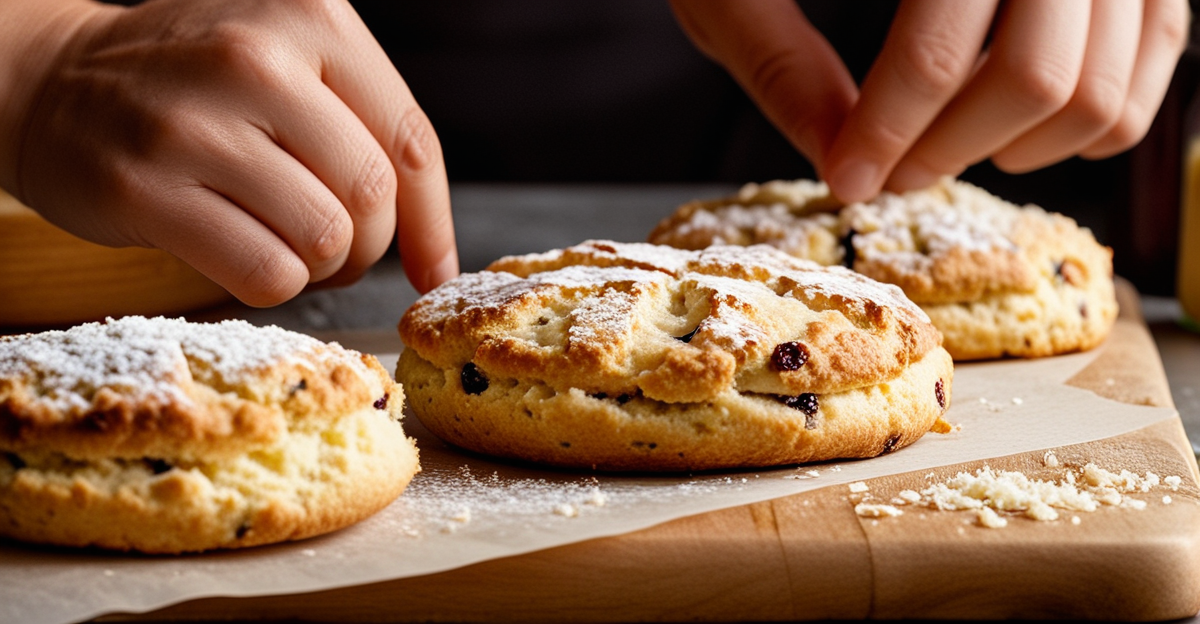Essential Techniques for Perfect Scones
Mastering scone baking basics starts with understanding the core ingredients and their specific roles. Flour provides the structure, while fat—usually butter—creates tenderness by coating the flour proteins, inhibiting gluten formation. Baking powder acts as the leavening agent, ensuring scones rise properly, and sugar adds subtle sweetness and aids browning. Milk or cream hydrates the mixture and adds richness.
Achieving the ideal dough texture is crucial for tender scones. The dough should be slightly sticky but not overly wet. Overworking the dough increases gluten development, leading to dense, tough scones. Gentle handling preserves lightness. Use the step-by-step scone making method: mix dry ingredients, cut in cold butter until the mixture resembles coarse crumbs, then add liquids just until combined. This technique minimizes gluten formation.
Have you seen this : What are the best tips for making a creamy Lancashire hotpot?
Mixing and handling tips are essential for perfect results. Keep butter cold to create flaky layers that melt during baking. Avoid rolling or pressing the dough too thin; 2 cm thickness is ideal for a soft interior and golden crust. Use a sharp cutter to create clean edges, which help produce an even rise. Chilling the shaped dough before baking can also improve texture by allowing the butter to firm up again.
By focusing on these expert scone techniques, you will consistently produce tender, flaky scones with the right crumb and rise. Remember, precision in ingredient handling and dough texture directly impacts the quality of your final bake.
Also read : How can you recreate a classic Eton mess at home?
Mastering Scone Preparation and Baking
Mastering scone shaping is essential for consistent results. To achieve even scone sizes, gently pat the dough into a uniform thickness—roughly 2 cm—before cutting. Use a sharp cutter without twisting to maintain clean edges, which ensures an even rise and a tidy appearance. Pressing or twisting the cutter can seal edges and inhibit proper rising.
Proper oven techniques start with preheating to a steady 200°C (390°F). This temperature promotes rapid oven spring, creating a tender crumb and golden crust. Baking scones on the middle rack allows heat to circulate evenly, preventing uneven browning. Bake for about 12-15 minutes; ovens vary, so adjust time as needed.
Testing for doneness is straightforward: scones should be golden on top and sound hollow when tapped beneath. Inserting a skewer or toothpick should yield no wet batter, although some moisture inside is normal for tender scones. Avoid overbaking to prevent dryness; if the tops brown too quickly, loosely tenting with foil helps.
Using these scone baking tips along with precise shaping and timing will yield expert results, building upon the foundation of step-by-step scone making to deliver beautifully risen, golden scones every time.
Troubleshooting and Perfecting Your Scones
Avoiding common scone mistakes starts with recognizing what causes dry or dense textures. Dryness typically results from overmixing the dough or using too much flour. When the dough is overworked, gluten develops excessively, making scones tough instead of tender. To fix this, return to step-by-step scone making by mixing just until ingredients combine and maintaining a slightly sticky dough.
If your scones turn out crumbly or fail to hold their shape, the problem often lies in insufficient fat or liquid. Butter acts not only as flavor but also as a tenderizing agent, coating flour particles. Using cold butter and cutting it evenly into the flour is essential. For crumbly scones, try carefully increasing cream or milk to hydrate the dough without making it wet. These adjustments embody key expert scone techniques that address texture imbalances.
Understanding the baking science behind scones clarifies why these techniques matter. Flour proteins create gluten, the framework for structure, but too much causes chewiness. Fat disrupts gluten chains, creating flakiness and tenderness. Baking powder releases gas bubbles that expand during baking, lifting the dough. Moisture controls texture softness but can also hinder rise if excessive. Knowing this interplay helps adapt recipes to ingredient variations or differences in equipment, a critical part of scone troubleshooting.
When equipment varies, such as ovens with uneven heat or fluctuating temperatures, adjusting your approach maintains quality. For example, lower baking temperatures slightly and lengthen baking times if browning occurs too fast. Additionally, chilling dough before baking can improve uniform rise, another expert scone technique enhancing scone quality despite external factors.
Mastering these troubleshooting principles ensures you confidently tackle issues and achieve consistent, delicious scones every time.
Essential Techniques for Perfect Scones
Mastering scone baking basics begins with selecting and understanding the core ingredients, each playing a vital role. Flour forms the structure by developing gluten, while fat—commonly cold butter—creates tenderness by coating those flour proteins and limiting gluten formation. Baking powder acts as the leavening agent; its role is crucial as it produces gas bubbles that make the scones rise and develop a light texture. Sugar, though used sparingly, contributes subtle sweetness and encourages browning, enhancing both flavor and appearance. Milk or cream hydrates the mix and enriches the crumb, balancing moisture for softness without compromising rise.
Achieving the ideal dough texture is essential. The dough should be slightly sticky but firm enough to hold shape; overly wet dough can spread during baking, while dry dough produces tough scones. This balance results from carefully following step-by-step scone making: start by mixing dry ingredients, then cut cold butter into the flour until the mixture resembles coarse crumbs. Adding liquids should be done gently and only until the dough just comes together to minimize gluten activation, which maintains tenderness.
Proper mixing and handling are fundamental expert scone techniques to acquire flaky, tender scones. Always handle dough lightly to avoid developing gluten excessively. Keeping butter cold is critical, as the solid fat creates pockets of steam during baking, which produce flaky layers in the final scone. When shaping, avoid kneading or over-rolling; instead, gently pat the dough to the desired thickness. These methods emphasize precision in both ingredient management and dough texture, ensuring that every bake results in scones with a perfect crumb and rise.
Essential Techniques for Perfect Scones
Achieving success in scone baking basics depends heavily on understanding the function of each core ingredient. Flour provides the structural backbone through gluten formation, which must be controlled carefully to avoid tough scones. Fat—usually cold butter—is essential to tenderize the crumb by coating flour proteins, limiting gluten development. It also creates steam pockets that contribute to flakiness. Baking powder serves as the leavening agent, producing gas bubbles that cause the dough to rise and yield a light texture. Finally, milk or cream hydrates and enriches the dough, balancing moisture for softness, while a small amount of sugar enhances browning and flavor.
In step-by-step scone making, achieving the ideal dough texture is paramount. The dough should be slightly sticky and cohesive but not wet or overly dry. A useful test is gently pressing the dough with fingers—it should hold shape but not crumble or stick excessively. This texture ensures the right balance for proper rise and tenderness. Overmixing activates gluten too much, causing dense scones, so mixing until just combined is essential.
Incorporating expert scone techniques during mixing and handling further refines the final product. Cutting cold butter into the dry ingredients until the mixture looks like coarse crumbs creates the flaky layers prized in well-made scones. When adding liquids, pour gradually and stir lightly, stopping as soon as the dough forms. Avoid kneading or pressing the dough excessively; instead, gently pat it to shape. These practices minimize gluten development and preserve the tender crumb structure that defines perfect scones.





